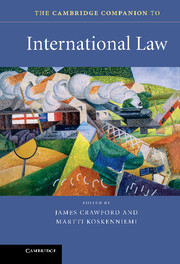Book contents
- Frontmatter
- Contents
- Preface
- Notes on contributors
- Introduction
- Part I The contexts of international law
- Part II International law and the state
- 4 Statehood
- 5 Sovereignty as a legal value
- 6 Exercise and limits of jurisdiction
- 7 Lawfare and warfare
- Part III Techniques and arenas
- Part IV Projects of international law
- Guide to electronic sources of international law
- International law chronology
- Select guide to further reading
- Index
- References
6 - Exercise and limits of jurisdiction
from Part II - International law and the state
Published online by Cambridge University Press: 05 July 2015
- Frontmatter
- Contents
- Preface
- Notes on contributors
- Introduction
- Part I The contexts of international law
- Part II International law and the state
- 4 Statehood
- 5 Sovereignty as a legal value
- 6 Exercise and limits of jurisdiction
- 7 Lawfare and warfare
- Part III Techniques and arenas
- Part IV Projects of international law
- Guide to electronic sources of international law
- International law chronology
- Select guide to further reading
- Index
- References
Summary
Introduction
For many, jurisdiction has the reputation of being a technical matter and thus of having a rather dry appeal, and not without cause. At the same time, the study of the rules assigning jurisdiction, limiting it and seeking to handle overlaps and tensions arising in this process of allocation is a fascinating lens through which to view the macro-structure of international law, since these very rules, in manifold ways, mirror the interplay, and conflict, of the governing principles of the international legal order.
The term ‘jurisdiction’ stems from the Latin ius dicere, which literally translates as ‘speaking the law’. In its widest sense, jurisdiction therefore means an entity’s entitlement to authoritatively say ‘what the law is’. In the context of international law, two principal uses of the term must be distinguished.
In a first instance, in the domestic as well as the international realm, reference is had to the ‘jurisdiction’ of institutional bodies. This concerns the question under what conditions institutions, particularly those of a judicial or quasi-judicial character, may pronounce on what the law is. As there exists no single institution entitled to address all questions it deems fit, it is crucial to assess the reach of a body’s jurisdiction and, correspondingly, to identify the limits of its jurisdiction. These limits typically manifest themselves on the temporal, spatial, personal and subject matter level.
- Type
- Chapter
- Information
- The Cambridge Companion to International Law , pp. 134 - 157Publisher: Cambridge University PressPrint publication year: 2012
References
- 6
- Cited by

